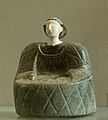Uzbek people facts for kids

Uzbek people
|
|
| Total population | |
|---|---|
| c. 30 million | |
| Regions with significant populations | |
| 23,929,309 (2013) | |
| 2,799,726 (2013) | |
| 1,210,236 (2013) | |
| 980,000 (2009) | |
| 499,862 | |
| 490,000 | |
| 300,000 | |
| 260,000 | |
| 80,000 | |
| 70,133 (2005) | |
| 50,795 (2014) | |
| 45,000 | |
| 22,400 | |
| 14,800 | |
| 560 | |
| Languages | |
| Uzbek | |
| Religion | |
| Mainly Islam (predominantly Sunni or Cultural Muslims), minority non-religious. Historically Tengriism |
|
| Related ethnic groups | |
| Other Turkic peoples | |
The Uzbeks are a large group of people who mostly live in Central Asia. They speak the Uzbek language, which is part of the Turkic language family. Most Uzbeks live in Uzbekistan, where they are the main population. You can also find many Uzbeks in neighboring countries like Afghanistan, Tajikistan, Kazakhstan, and Kyrgyzstan. Smaller groups of Uzbeks live in other parts of the world, including Russia and China.
Contents
Who are the Uzbeks?
Uzbeks are one of the largest ethnic groups in Central Asia. They have a rich history and culture. Their language, Uzbek, is closely related to other Turkic languages spoken across Central Asia and beyond. Most Uzbeks follow the Islamic faith, mainly the Sunni branch.
Where do Uzbeks live?
The country of Uzbekistan is home to the largest number of Uzbek people. It is their main homeland. However, many Uzbeks also live in countries that border Uzbekistan. These include Afghanistan, Tajikistan, Kazakhstan, Kyrgyzstan, and Turkmenistan. There are also Uzbek communities in other countries around the world, like Russia, Saudi Arabia, and even the United States.
Uzbek Culture and Traditions
Uzbek culture is very vibrant and has been shaped by many different influences over centuries.
Language
The Uzbek language is the official language of Uzbekistan. It belongs to the Turkic language family, which means it shares roots with languages like Turkish, Kazakh, and Kyrgyz. There are different dialects of Uzbek, but they are generally understood by most speakers.
Religion
Most Uzbeks are Muslims, following the Sunni branch of Islam. Islam plays an important role in their daily lives, traditions, and festivals. Mosques are common places for prayer and community gatherings.
Food
Uzbek cuisine is famous for its delicious dishes. One of the most well-known is Palov (also called Plov or Osh), a rice dish cooked with meat (often lamb or beef), carrots, and onions. Other popular foods include Samsa (savory pastries), Lag'mon (noodles with meat and vegetables), and various types of bread, like non.
Clothing
Traditional Uzbek clothing is colorful and often made from silk or cotton. For men, this might include a chapan (a long, quilted coat) and a do'ppi (a square or round cap). Women often wear bright, patterned dresses and headscarves. These traditional clothes are still worn for special occasions and holidays.
Music and Dance
Music and dance are very important parts of Uzbek culture. Traditional music often features instruments like the dutar (a two-stringed lute) and doira (a frame drum). Folk dances are graceful and tell stories, often performed during celebrations.
History of the Uzbek People
The history of the Uzbek people is long and complex, tied to the ancient Silk Road and powerful empires.
Early History
The region where Uzbeks live today has been a crossroads for many different groups for thousands of years. Over time, various Turkic tribes settled in the area. The name "Uzbek" became more common around the 15th century, referring to a group of Turkic-Mongol tribes who moved into the region.
Famous Figures
One of the most famous historical figures associated with the region is Timur (also known as Tamerlane). He was a great conqueror who lived in the 14th century and built a vast empire with its capital in Samarkand. While Timur himself was not an "Uzbek" in the modern sense, his empire and the culture he fostered greatly influenced the people and lands that would later become Uzbekistan.
Modern Times
In the 20th century, the lands where Uzbeks lived became part of the Soviet Union. After the Soviet Union broke apart in 1991, Uzbekistan became an independent country. This allowed the Uzbek people to further develop their own national identity and culture.
Related pages
Images for kids
-
Female statuette bearing the kaunakes. Chlorite and limestone, Bactria, beginning of the 2nd millennium BC
-
Timur feasts in Samarkand
-
A lithograph of two Uzbek Khans from Afghanistan in 1841.
-
Uzbeks in Samarkand in 1964
See also
 In Spanish: Uzbekos para niños
In Spanish: Uzbekos para niños











